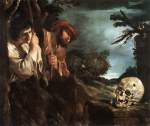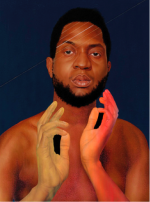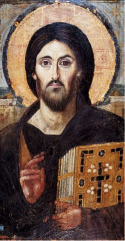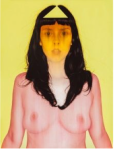By Kristin Buechelmaier
Jenny Morgan’s Arcadia depicts a half-length nude woman who is most provocatively characterized by the skull that she holds in her hands, where it appears adjacent to her left breast; the roundness of the skull complements the curvature of the breast but also sets up a material and symbolic conflict of hard and soft, bone and flesh. The nubile woman evokes life while the skull is a memento mori, or a reminder of death. Other aspects of Arcadia including; the title of the work, the distortion of the woman’s blue eyes, her enflamed red hands, and the faint lines of an abbreviated triangle superimposed on the skull contribute to the painting’s mystical themes of life and death.
Morgan’s Arcadia offers a variety of visual and symbolic analogies and oppositions. The figure appears against a dark, ambiguous background, which further focuses attention on the lightest parts of the painting, specifically the left breast and skin of the woman’s chest surrounding the skull. The orientation of the skull, positioned so that it too faces out of the canvas, echoes the woman’s forward posture and gaze, as she peers out to the viewer with hazy blue eyes. Her blue eyes are distorted, the still wet paint streaked with a dry brush, which creates another source of tension in Morgan’s piece, which is otherwise masterfully in realistic and tightly painted. The figure’s naked flesh is in conflict with the bones that make up the skull—the skin, light and smooth and the skull, dark and coarse. The slight angle in the position of the skull generates tension with the asymmetrically superimposed triangle. The triangle further unbalances the skull; its apex occurs just left of the vertical axis of the skull, but just right of the vertical of the woman’s face above, to which the triangle seems to point.
Even the title of Morgan’s work, Arcadia, assists in enhancing this theme of life and death. The classical “Arcadia,” a rural region of ancient Greece, is thought of as an “idyllic and blissful place, where young shepherds and shepherdesses roam with their flocks in an everlasting spring and engage in poetry contests.” [1] “Arcadia” is much like the Biblical Garden of Eden, a paradise where the thought of death is unheard of and life is ideal (see Figures 2 and 3). Ironically, however, Morgan includes a memento mori, the skull, within her piece which seems to contradict the Arcadian ideal for it acts as a reminder of death. In this surprising twist Morgan alludes to conceptions of Arcadia in mythology, literature, and art history in which death shadows youth and beauty, as seen for instance in works entitled Et in Arcadia ego (see Figures 4 and 5) depicted by both Giovanni Francesco Barbieri (ca. 1618–1622) and Nicolas Poussin (1637–1638). The Latin phrase “Et in Arcadia ego,” meaning “Even in Arcadia, there am I,”[2] signifies that even in Arcadia, even in paradise death is present.[3] In their distinct depictions of the Et in Arcadia ego theme, both Poussin and Barbieri include shepherds (as symbols of Arcadia), in addition to a symbol of death; for Poussin, the symbol of death is a tomb (see Figure 5) and for Barbieri, it is a grinning skull atop what appears to be a tomb (see Figure 4). Both works depict this push and pull between the ideas of life and death.
In Morgan’s Arcadia, the push and pull is not only between life and death but also between reality and unreality, body and spirit. Morgan, though considered a Realist figure painter, intentionally obscures her own works, which she calls, “messing up her realist hand,” in order to illuminate the spiritual aspects of the figures of whom she paints.[4] Through sanding and other various techniques, Morgan is able to reveal a ghostly image of the realistic figure that she created in order to symbolically reveal the spirit and internal self of the figure. This approach is evident in much her work, including Arcadia, which also exhibits a mysterious dab of white paint to the left of the woman’s head. The flat speck of white, what Morgan calls a “spirit orb,” breaks up the illusion of the painting and serves as a reference to the hereafter.
Morgan’s work is immensely influenced by the personal spiritual or religious ideas. Works like A Baby Named Love Psychedelic (Figure 6) and Power Play (Figure 7), display this notion of the spiritual or the religious. In A Baby Named Love Psychedelic, the artist creates a faint halo around the woman’s hair and highlights her pregnant belly, evoking the mystical associations of the pregnancy and the female body in religious tradition. In Power Play, the figure’s posture and gestures strongly recall medieval icons of the “Christ Pantocrator” (Figure 8).[5]
The triangle in Arcadia also arouses mystical and historical associations. Historically in art, the triangle was utilized as a compositional framework in Renaissance art; especially in religious works.[6] In the High Renaissance, for instance, the triangle composition can clearly be seen in the some of the most famed religious works of Michelangelo, Raphael, and Leonardo da Vinci (see Figures 8 and 9). In Christianity, the triangle has obvious connections to the Trinity.[7]
Beyond its religious associations, the triangle encompasses a myriad of symbolic meanings from gender to balance to intelligence to love to the elements. However, it is the symbolic meaning behind the particular orientation of the triangle that is perhaps most important to Morgan’s Arcadia. Point-up triangles act as a representation of ascent toward the spiritual world, whereas point-down triangles represent the descent into the physical world[8], two meanings that coincide seamlessly with the theme of life and death. Morgan tends to include this triangle element in many of her works as in Opening Ceremony (Figure 10).
It is through the various poignant objects within Arcadia that Jenny Morgan is able to convey this idea of life and death. Morgan skillfully does so by incorporating classical imagery and referencing the spiritual in her painting. She does so by including the concept of Arcadia in the work’s title, including the memento mori of the skull and its opposition to the breast, and by the inclusion of the triangle. Morgan’s artistry and technical approach further sharpen the painting’s push and pull of spirit and body, life and death.
[1] For more information about “Arcadia” refer to Phenomenology of Life: Meeting the Challenges of the Present-Day World Volume 84 edited by Anna-Teresa Tymieniecka (page 255).
[2] For more information on the translation of “Arcadia” refer to Tom Stoppard’s Arcadia by John Fleming.
[3] For more information on “Et in Arcadia Ego” and its translation, refer to Erwin Panofsky’s Meaning in the Visual Arts (1983).
[4] For more information on Jenny Morgan’s artistic process watch Emily V Driscoll’s film, How to Find A Ghost.
[5] For more information on the icon of “Christ Pantocrator” refer to Solrunn Nes’ The Mystical Language of Icons (2005).
[6] For more information on the symbolic and conventional nature of the triangle in art history, refer to Rebecca Zorach’s The Passionate Triangle.
[7] For more information on the Trinity and the theology behind the Trinity, refer to The Trinity by Roger E. Olson and Christopher Alan Hall.
[8] For more information on symbols, such as the triangle, and their meanings refer to The Element Encyclopedia of Secret Signs and Symbols: The Ultimate A-Z Guide from Alchemy to the Zodiac by Adele Nozedar.










